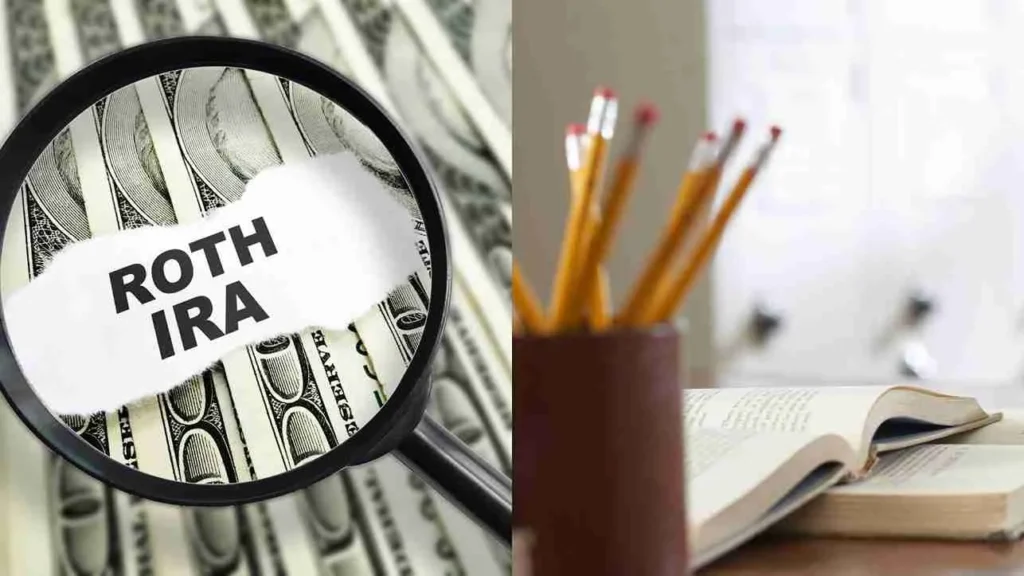Teachers, it’s time to secure your financial future by investing wisely for retirement. While 403(b) accounts are a common option among educators, consider taking advantage of the Roth IRA, which could complement or even replace your 403(b).
Today, you will learn:
- What is a Roth IRA?
- Is a Roth IRA Right for School Teachers?
- Potential Risks of Roth IRAs
- Potential Fees to Watch Out For
- Comparing Roth IRAs to 403(b) and 401(k) Plans
What is a Roth IRA?
A Roth IRA is a type of individual retirement account that allows you to save for retirement after-tax. Unlike traditional IRAs and 403(b) plans, where you deduct your contributions from your taxable income, Roth IRA contributions are made with after-tax dollars. This means you pay taxes on the money upfront, but your withdrawals in retirement are tax-free.

Is a Roth IRA Right for School Teachers?
The decision of whether to use a Roth IRA depends on your circumstances and financial goals. However, for many school teachers, Roth IRAs can be a powerful tool to accumulate wealth for retirement. Here are some of the reasons why Roth IRAs may be particularly beneficial for school teachers:
- Tax-Free Withdrawals in Retirement: If you expect to be in a higher tax bracket in retirement, Roth IRAs can provide significant tax savings. Withdrawing your tax-free contributions and investment earnings can significantly boost your retirement income.
- Flexibility and Control: Roth IRAs offer more flexibility in how you use your retirement savings compared to 403(b) plans. There are no required minimum distributions (RMDs), allowing you to control the timing of your withdrawals. You can also withdraw your contributions at any time without penalty, providing access to your funds for emergencies or other needs.
- Long-Term Growth Potential: Roth IRAs offer the potential for long-term wealth accumulation due to tax-free compounding. As your investments grow, you can enjoy tax-free withdrawals in retirement, potentially maximizing your retirement income.
Potential Risks of Roth IRAs
While Roth IRAs offer several advantages, there are also potential risks to consider:
- Taxable Contributions: Unlike 403(b) plans, where you deduct your contributions from your taxable income, Roth IRA contributions are made with after-tax dollars. This means you pay taxes on your contributions upfront, which can be a burden for those with a lower tax bracket now but expect to be in a higher bracket in retirement.
- Limited Contribution Limits: The maximum contribution you can make to a Roth IRA each year is $6,000 in 2023, and there are additional restrictions based on your income. This may not be enough for teachers who want to save a significant amount for retirement.
Potential Fees to Watch Out For
Like any investment account, Roth IRAs may have associated fees, including:
- Administrative Fees: These fees are charged by the IRA custodian for managing your account and providing account statements.
- Investment Management Fees: If you opt for managed investment options within your Roth IRA, you’ll incur additional fees for professional investment management.
- Early Withdrawal Fees: While you can withdraw your contributions at any time without penalty, there may be penalties associated with withdrawing earnings before the age of 59½.
Comparing Roth IRAs to 403(b) and 401(k) Plans
Roth IRAs can be a complementary or alternative option to 403(b) plans, which are retirement plans offered by employers to nonprofit organizations, including public schools. Both Roth IRAs and 403(b) plans offer tax-deferred growth, but there are some key differences:
- Contribution Limits: The annual contribution limit for Roth IRAs is capped, while contribution limits for 403(b) plans vary depending on the employer and the plan structure.
- Employer Matching: Some employers offer matching contributions to their employees’ 403(b) plans, which can significantly boost your retirement savings. Roth IRAs do not offer employer matching contributions.
- Tax Treatment on Withdrawals: Roth IRA withdrawals are tax-free in retirement, whereas 403(b) withdrawals are typically taxed as ordinary income.
Conclusion
Roth IRAs can be a valuable addition to your retirement savings strategy, especially if you expect to be in a higher tax bracket in retirement. They offer tax-free withdrawals, flexibility, and long-term growth potential. However, it’s important to consider the potential risks.
Disclosure: This information is for educational purposes only and should not be construed as financial advice. Please consult with a qualified financial advisor before making any investment decisions.

About Author
Bill Wallace blends his academic background in Literature with his ventures in International Business and finance. His professional journey took him across Europe, especially in Spain, where his passion for writing evolved. Since then, armed with his literary finesse and investment acumen, he has been crafting financial content for teachers worldwide. More about me.
Similar Read:





